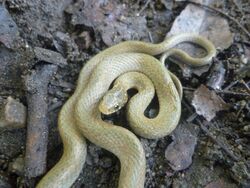Biology:Japanese keelback
| Japanese keelback | |
|---|---|

| |
| Scientific classification | |
| Domain: | Eukaryota |
| Kingdom: | Animalia |
| Phylum: | Chordata |
| Class: | Reptilia |
| Order: | Squamata |
| Suborder: | Serpentes |
| Family: | Colubridae |
| Genus: | Hebius |
| Species: | H. vibakari
|
| Binomial name | |
| Hebius vibakari | |
| Synonyms | |
| |
The Japanese keelback (Hebius vibakari) is a species of colubrid snake, which is endemic to Asia. It was first described in 1826 by Heinrich Boie as Tropidonotus vibakari.[2][3]
Geographic range
It is found in northeastern China , Japan (Honshu, Kyushu, Shikoku), Korea, and Russia (Amur Oblast, Khabarovsk Krai, Primorsky Krai).[4]
Description
It is a small snake, growing to a maximum total length of 44 cm (17 1⁄4 in), with a tail 10 cm (3 7⁄8 in) long.
Dorsally it is olive or reddish brown, with small blackish spots. Some specimens may have a dark olive or blackish vertebral stripe. The upper labials are yellow, with black sutures. On each side of the nape of the neck there is a yellow dark-edged diagonal streak, these two streaks converging posteriorly. Ventrally it is yellow, with a series of brown dots or short lines at the outer ends of the ventral scales.
Dorsal scales strongly keeled (except outer row), arranged in 19 rows at midbody. Ventrals 127–151; anal plate divided; subcaudals divided 59–79.[5]
References
- ↑ Borzee, A., Kidera, N., Borkin, L., Orlov, N.L. & Working Group. (2021). "Hebius vibakari". IUCN Red List of Threatened Species 2021: e.T192162A2049133. https://www.iucnredlist.org/species/192162/2049133. Retrieved 20 November 2021.
- ↑ 2.0 2.1 ITIS (Integrated Taxonomic Information System: Hebius vibakari). www.itis.gov.
- ↑ 3.0 3.1 Boie, H. "Merkmale eineger japanischer Lurche". Isis von Oken 19: 203–216 [207]. https://www.biodiversitylibrary.org/page/27510761.
- ↑ 4.0 4.1 "The Reptile Database: Hebius vibakari". https://reptile-database.reptarium.cz/species?genus=Hebius&species=vibakari.
- ↑ Boulenger, G.A. 1893.Catalogue of the Snakes in the British Museum (Natural History). Volume I., Containing the Families...Colubridæ Aglyphæ, Part. Trustees of the British Museum (Natural History). London. xiii + 448 pp. + Plates I.-XXVIII. (Tropidonotus vibakari, pp. 221-222.)
Wikidata ☰ {{{from}}} entry
 |


